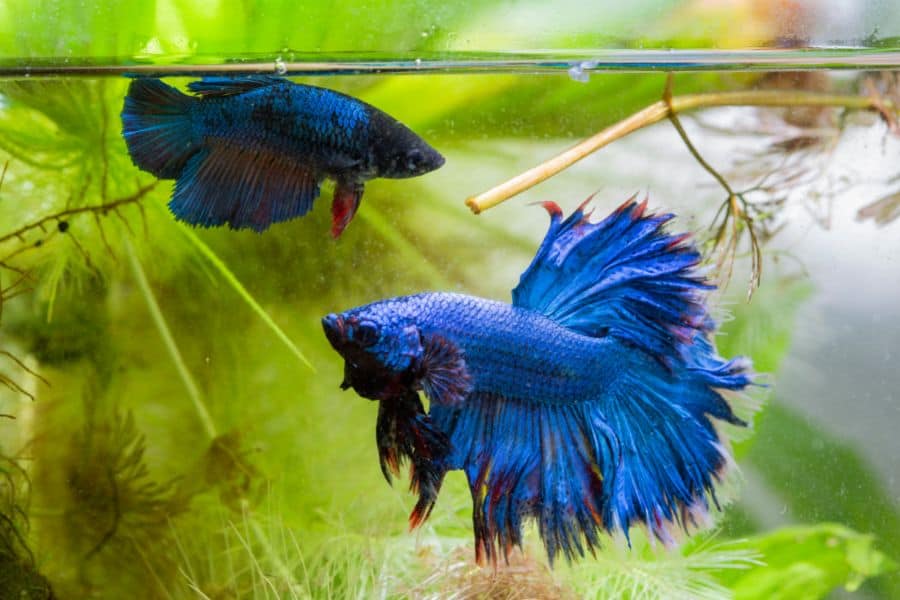Breeding betta fish can be an enjoyable process with great rewards. You’ll have the opportunity to watch as your breeding efforts pay off, producing beautiful new generations of bettas for you to admire and love.
Whether you’re breeding bettas for show or just to enjoy yourself, you’ll find that there are many considerations when it comes to breeding betta fish!
Without further ado, here’s everything you need to know about breeding betta fish!
Betta Fish Breeding Season
Captive Betta fish don’t have a regular breeding or mating season, unlike other species of fish. Bettas will spawn year-round if they are in the proper breeding condition and the environmental conditions are right.
However, in the wild, Betta fish typically spawn between February and June, as this is when the water temperatures are warmer and breeding is easier.
Since the aquarium is typically a controlled environment, the conditions should be stable enough that Bettas can spawn whenever they want to.
How to Know if Your Betta Is Ready to Breed
When betta fish are ready to breed, they exhibit different behaviors. However, there are times when people miss the signs, so be sure to watch out for them.
Here are some of the early breeding signs to look for in your breeding pair of bettas:
Bubble Nests
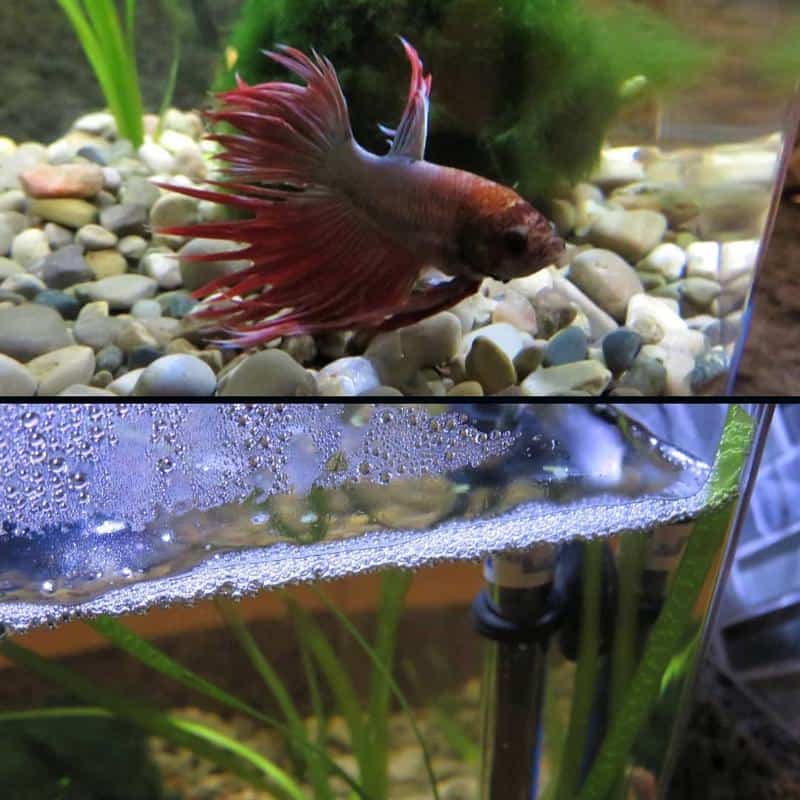
A male betta fish will build a bubble nest when he is prepared to mate. These bubble nests will resemble a clump of tiny bubbles and float at the very top of the tank. Once the nest is created, male betta fish frequently remain there while they look for a female partner.
Male betta fish will use their jaws to place the eggs into the bubble nest after they have been laid. The baby betta fish can live in a sterile, humid, and oxygen-rich environment thanks to the bubble nest.
To safeguard the eggs from potential predators, the male betta fish will remain under the nest. He will put the eggs back in if any happen to slip out.
Flaring
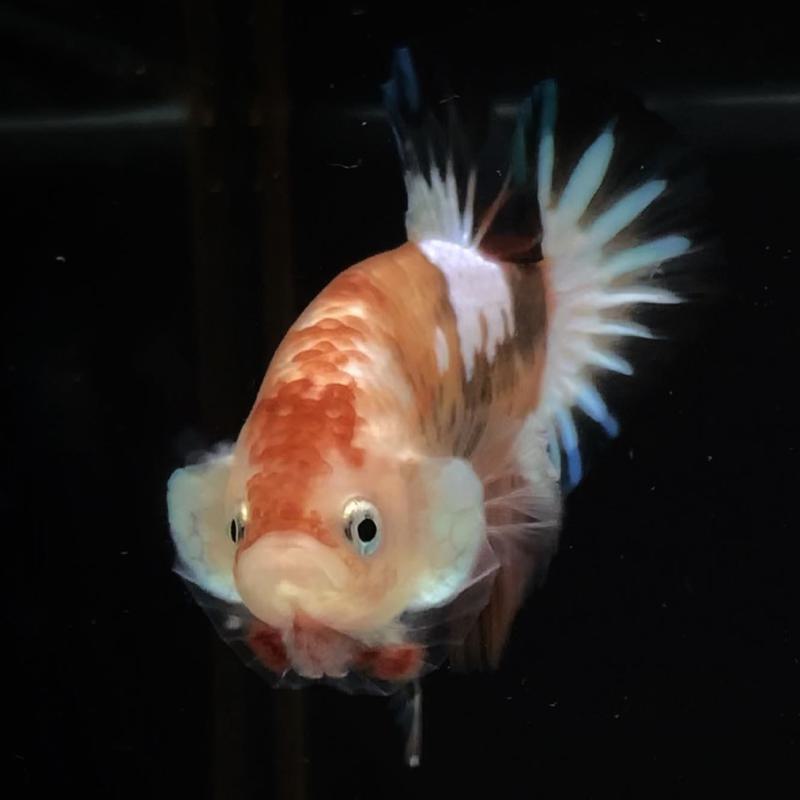
Flaring is an aggressive display designed to keep other fish from invading the Betta’s territory. It’s also a way for betta fish to show dominance and is also a pre-mating behavior.
Male Betta fish will spread their fins wide, darken their colors, and point their gills forward in an attempt to intimidate other males or attract a female.
That said, while it’s normally a male activity, female Bettas will occasionally engage in it as well.
Female Bettas choose one fish out of several suitors, while male Bettas flare in this manner in the wild as a type of competitiveness.
One way to test it is to put a male and a female Betta in two transparent jars that are placed next to one another. If you see the female flaring at the male, there’s a chance that it’s willing to spawn with him.
However, it’s important to remember that flaring doesn’t always indicate a mating dance. Keep a watch on the two fish for indications of aggressive behavior (on the side of the male Betta) and separate them if necessary.
If you’ve already put the two in a tank together, you may be certain that the two fish are considering spawning if you spot a bubble nest on the water’s surface.
Color
The white dot near the ovipositor tube, which is located behind the ventral fin, is the most blatant indicator of a receptive or gravid (egg-filled) female.
You should already be able to notice this dot while she is in her home tank, but it will be much easier to observe in the breeding tank, where the breeding pair will be separated from other fish.
The betta female will darken in color, show more of her ovipositor, and develop vertical bars. In male bettas, a deepened color also indicates readiness.
Large Belly
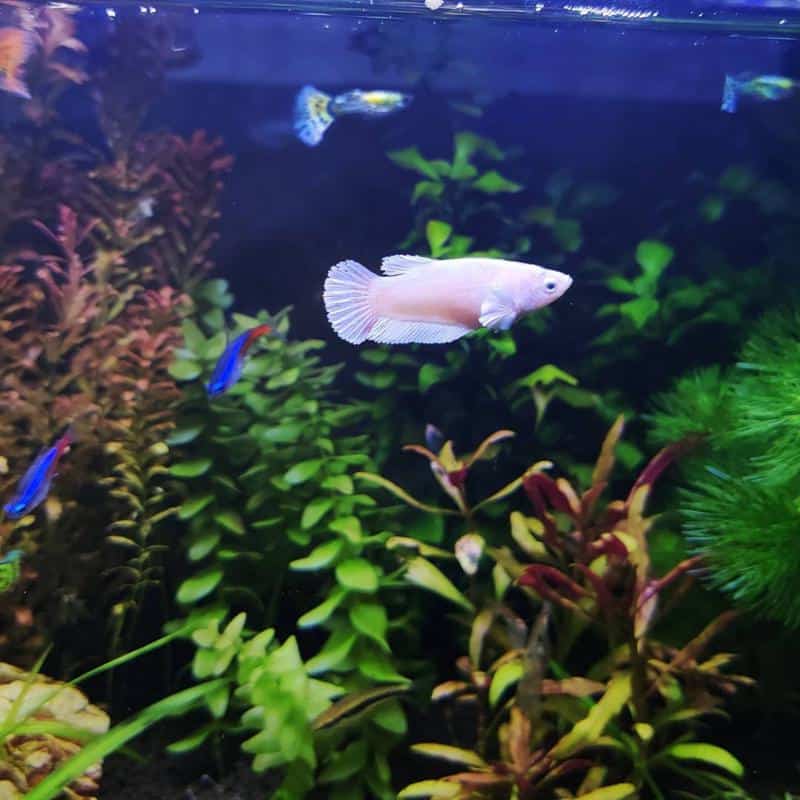
If your female Betta is ready to breed, you will observe that she has a large belly. Of course, this doesn’t always mean that she has eggs, as it could simply result from eating a lot.
Test your female Betta to see whether she is ready to mate by feeding her only a small quantity of food for a day. If her tummy is still large, it’s a sign that she has eggs.
How to Choose a Breeding Pair
Now that you know how to tell if your Bettas are ready, it’s time to choose breeding pairs for your betta fish. As a beginner, it’s also best to look for an experienced breeder to give you advice on the process, as breeding bettas can be a bit tricky.
Here are some general tips when choosing a great Betta breeding pair.
- Look for healthy fish with vibrant colors and no signs of illness or deformities.
- Avoid breeding Betta fish from the exact same line, as this can result in genetically weaker fry.
- Choose Betta fish with longer fins that are not torn or damaged.
- Consider breeding from different strains — different colors, patterns, and fin lengths.
- If breeding Betta fish from two different strains or colors, get a third breeding pair.
Explaining Betta Genetics
The breeding of Bettas is an interesting and complex endeavor, one that requires a lot of knowledge and attention to detail. It is important to understand how Betta genetics work in order to be successful at breeding Bettas.
The color of Betta depends on their cell types, and these are passed down from parent to offspring.
For example, a black Betta can produce either all black or all blue offspring, depending on what color cell type it has. The amount of genetic variation possible in breeding Bettas is quite high and increases with each breeding pair added.
Bettas have two forms for each gene—one dominant form and one recessive form—and these forms can be passed down from generation to generation. Dominant traits will always show up in the offspring, while recessive traits are only visible if two copies of the gene are present.
Additionally, the location of these cells also matter. A betta has roughly four different color layer kinds, each with a unique form of color cell. These variously colored skin cells can be found in many skin layers.
Keep in mind that the following description of the various color layers only takes into account the body. Since the fins are significantly thinner, the composition of the color layers there is presumably completely different.
The color layers in Bettas include:
- Blue Layer (Top)
- Black Layer
- Red Layer
- Yellow Layer (Bottom)
In wild Betta fish, the black and red layers are typically switched in order. That said, they still contain all four, just like domesticated Bettas.
Below, we’ll explain each layer in more detail so that you can better understand how pigmentation works and why breeding bettas can produce so many different colors.
Blue Layer (Iridiscent layer)
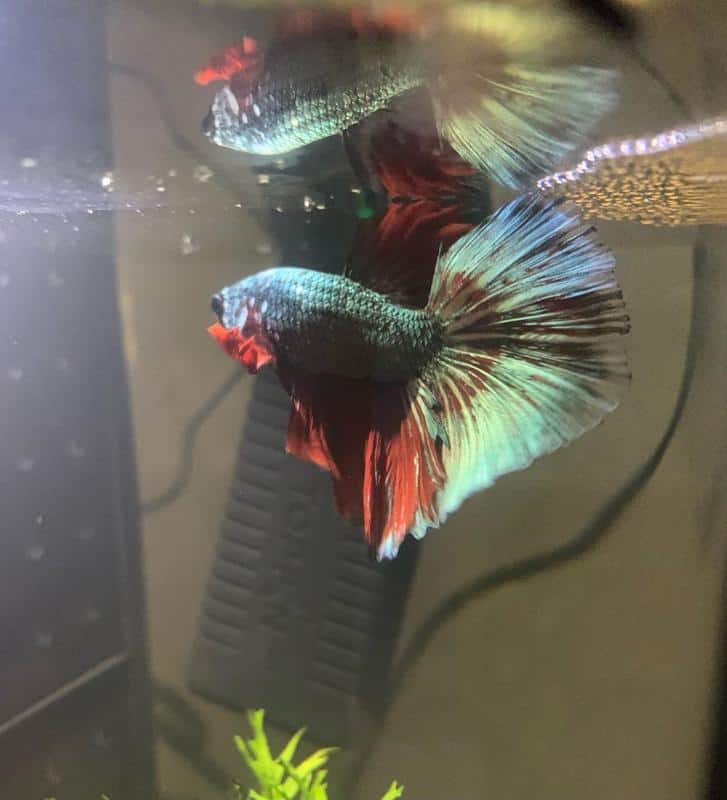
The blue layer, also known as iridiscent, is the topmost layer and usually consists of turquoise or blue cells, although copper-colored cells are also present. The color of the cell depends on the amount of guanine in them, which is determined by the genetics of both breeding pairs.
Iridophores, or Guanophores (green/blue cells), have the following variations:
- Blue/green (royal blue, green, and steel blue) (royal blue, green, and steel blue)
- Spreading iridocytes (turquoise blue)
- Non-blue (complete absence of blue) (total absence of blue)
The B1 gene stands for the blue/green color. B1 can produce the following three variations:
- A steel-blue fish is created from iridescent steel-blue materials.
- Iridescents in royal blue create a fish that is that color — B1b1
- Green iridescent creates the appearance of a green fish
You can see that if you crossbreed two steel blue bettas (b1b1 x b1b1), the offspring will be entirely steel blue. Similar to this, all of the offspring from a crossbreeding of two green betta fish (B1B1) will be green. The fry, on the other hand, will be 50% royal blue, 25% green, and 25% steel blue if you crossbreed a pair of royal blue bettas (B1b1 x B1b1).
Spread Iridocytes
This particular gene contributes to the vibrant color of turquoise seen in bettas. These crystals, known as iridocytes, create a luminous hue that exhibits hues from blue-green. The result? Bettas with an eye-catching metallic sheen.
Spread Irodocytes is the name for the genetic variation SiSi that makes the betta’s iridescence more prominent. Although the gene is still not fully understood, it is known that Si-Si results in significantly less iridescence.
Non-Blue
When you get a betta offspring that doesn’t have a blue layer, it means that it has a Non-Blue gene. While there’s no way for a gene to totally eradicate blue characteristics in Bettas, some breeders have managed to create specimens without any trace of this blue coloration.
However, it’s still up for debate, even among experienced breeders. Some breeders think it’s completely impossible.
What we know is that if a Bl-Bl is coupled with Si-Si, the blue layer may be very thin and produce only a faint silver appearance, making it difficult to tell if the color is blue at all.
Red Layer
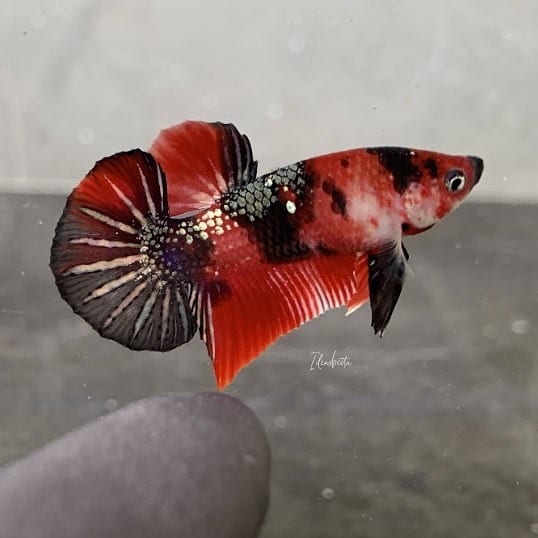
The red layer is the second layer and is made up of Erythrophores, red or pink cells, depending on the breeding pair’s genetics. This layer is responsible for the majority of the coloration in a betta.
Erythrophores can result in these variations:
- Red indefinite (Red covering the whole body and fins)
- Diminished Red (Body is a dark color, blue or green, and red covering just fins)
- Non-Red (Total absence of red)
- Varying Fins (The butterfly effect)
The amount of red in a betta will be determined by the aforementioned 4 genes. This is how red is such a common color in Bettas, and how you may see red streaks even in Bettas that are supposedly a different color.
For instance, there are many Blue Betta fish that still have streaks of red in them, despite being marketed as solid Blue.
Extended Red
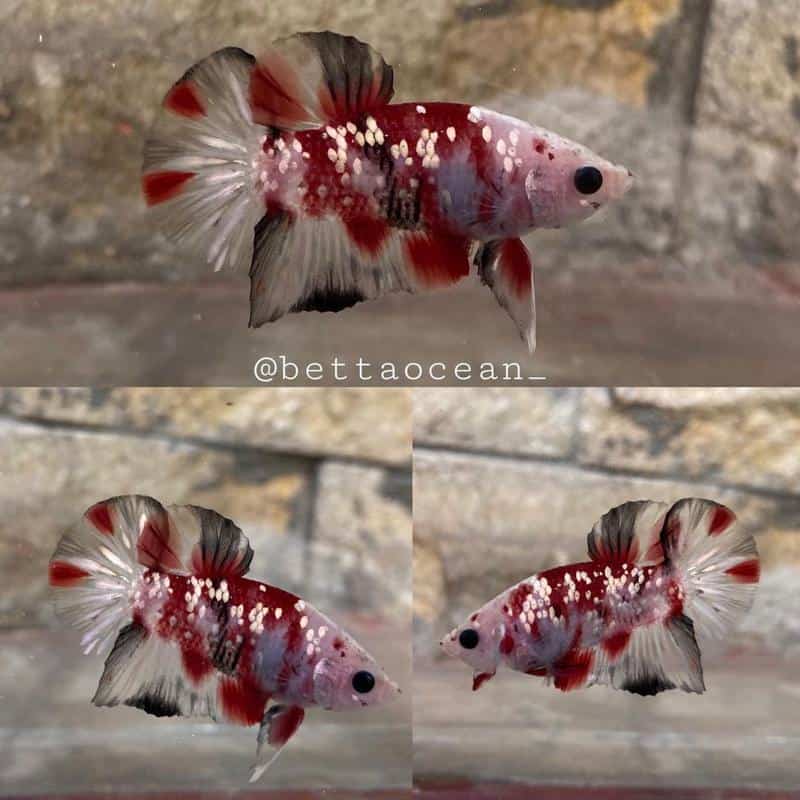
The R-extended red gene will regulate the amount and location of red in a betta.
Extended Red refers to the red covering the full body and fins, which is what breeders who want solid red Bettas are hoping for. A greater red distribution is marked by (RR), while a lesser red distribution is marked by (rr).
Reduced Red
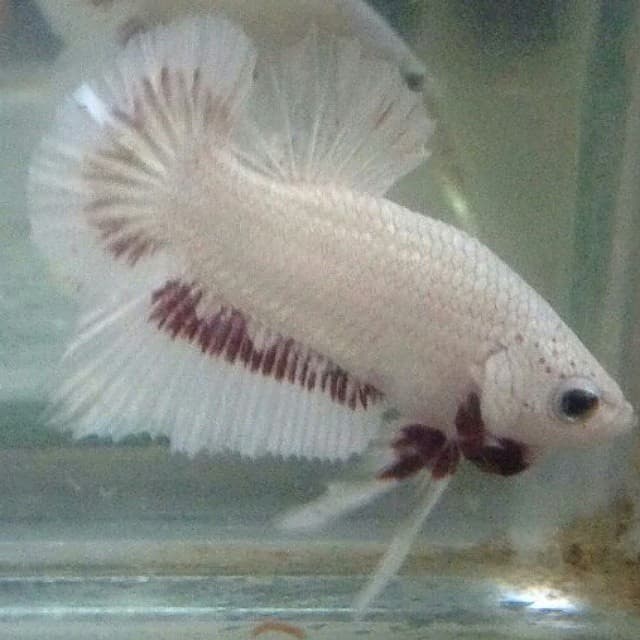
Reduced Red Bettas will have red fins and darker body colors (blue, green, or black). There is no known gene that lessens red, so theoretically, if you breed a Reduced Red Betta with another Reduced Red Betta, their fry will still possess the Reduced Red gene.
Non-Red
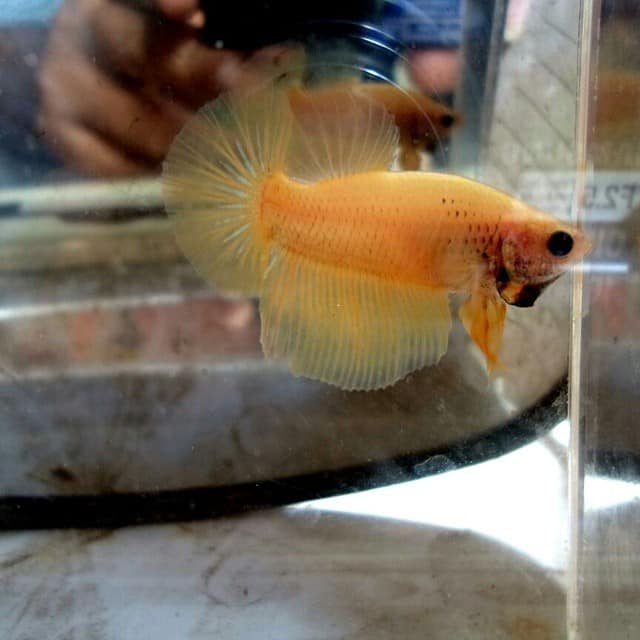
Non-Red is a double-recessive Nr-Nr gene that lacks the color red. Most people think that the non-red gene alters the pigment, turning it somewhat from red to yellow.
However, the gene actually removes the visible red color from the Betta’s body. That’s why breeding two Non-Red Bettas will result in a fully yellow fish with no red coloration.
Variegated Fins
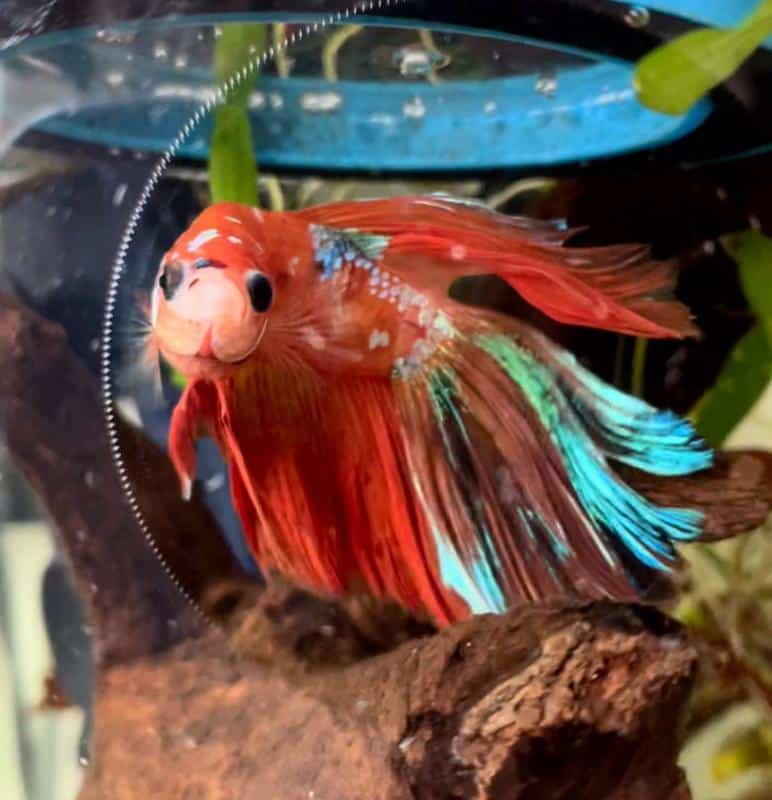
This gene is also known as the butterfly gene (Vf), since it produces the effect known as the butterfly coloration. Variegated fins are marked by random stripes and patterns of color in the fins.
This is caused by a mutation that deactivates some parts of the Erythrophores and Xanthophores. The gene is dominant, so breeding two Variegated Fin Bettas will result in offspring with variegated fins.
Black Layer
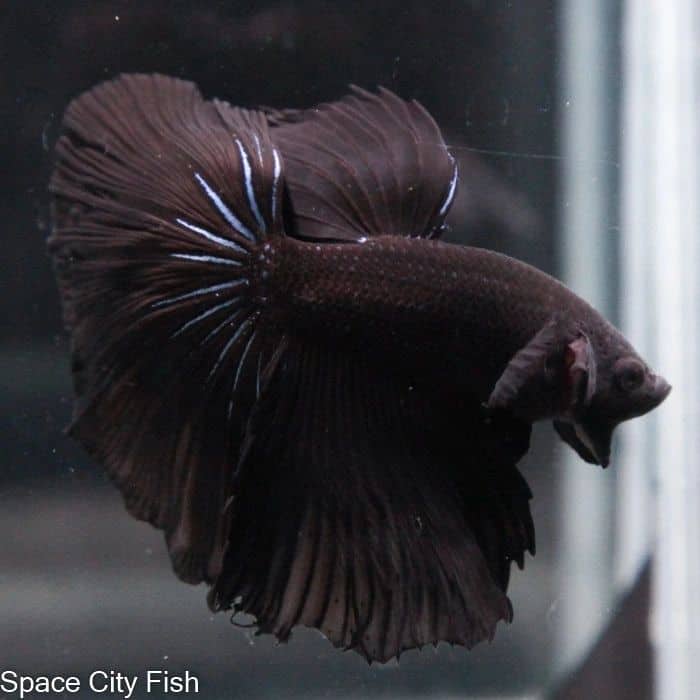
The black layer is the last layer, made up of melanophores or black cells. This gene is responsible for the black undertones in a betta’s coloration. It also creates dark edges to the dorsal and anal fins, as well as patterns on the caudal fin.
Melanophores have the following variations:
- Melano (Black Bettas)
- Cambodian (Creamy body, red fins)
- Blond and vibrant (a bright “Cherry” color)
Melano
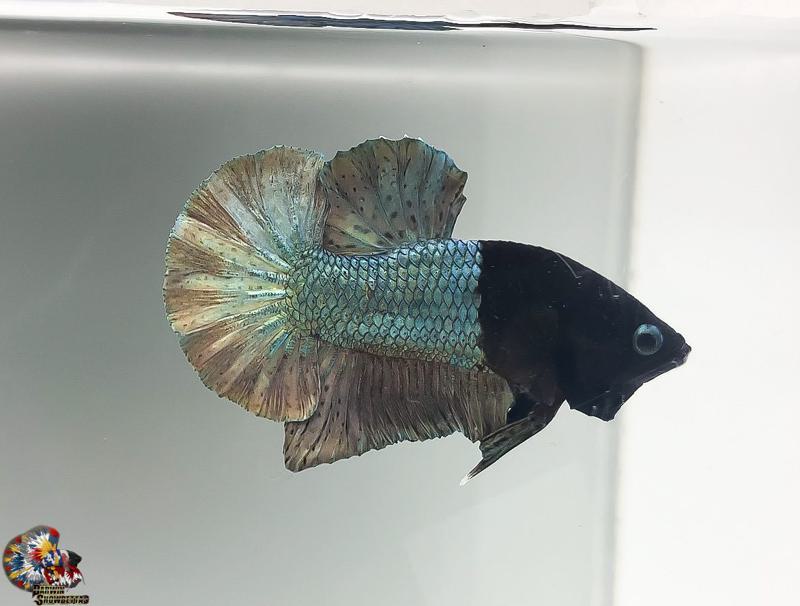
With the double-recessive Melano gene, bettas have an increased amount of black pigmentation which results in a jet-black fish. Unfortunately, many Melano females are infertile. They can still spawn eggs, but nothing will come out of them. It’s believed that some of the adhesion proteins found in these melanophores cause female infertility.
Due to this, aquarists interested in breeding Melano fry will have to breed their black male with a blue or, even better, a black lace female.
Cambodian
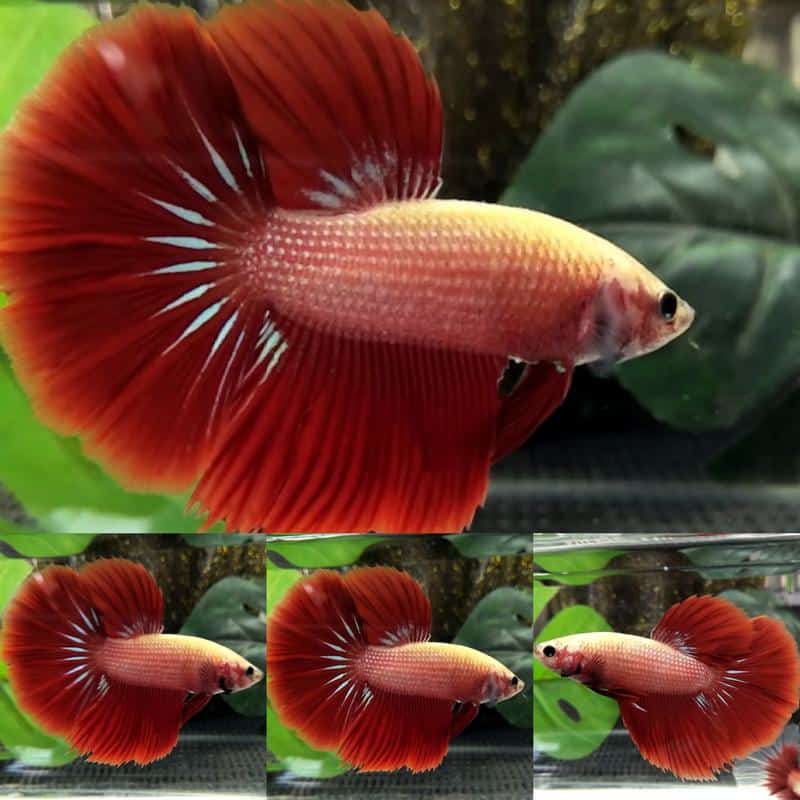
Cambodian refers to the variety of Betta that has a flesh or light-colored body and red fins.
The Cambodian gene, which is symbolized by the letter cc, is double-recessive, which means you need to have two Bettas with this recessive gene in order to have offspring with the same trait.
Blond and Vibrant
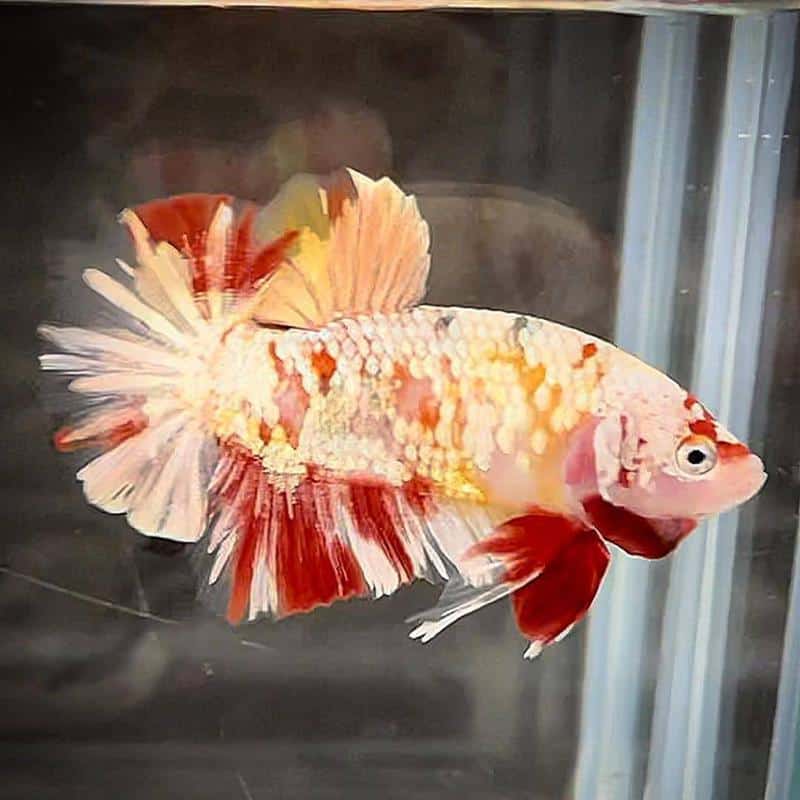
Blond and vibrant refers to Bettas that have fewer dark pigments on their bodies, at least when compared to solid blacks and Cambodian varieties. Instead, blonde Bettas have yellow or pastel bodies, hence the name.
When combined with other color genes, the results can be pretty incredible. Blonde steel blue Bettas have a lustrous silver tone while blonde blacks have an almost faded or pale look to them. Meanwhile, blond reds have an extremely vibrant, striking color as opposed to regular reds.
The Blond variant is recessive, so you’ll need two Bettas with the blonde gene to increase your chances of getting this type of offspring.
If the gene isn’t present, though, the Betta will look considerably darker.
Yellow Layer
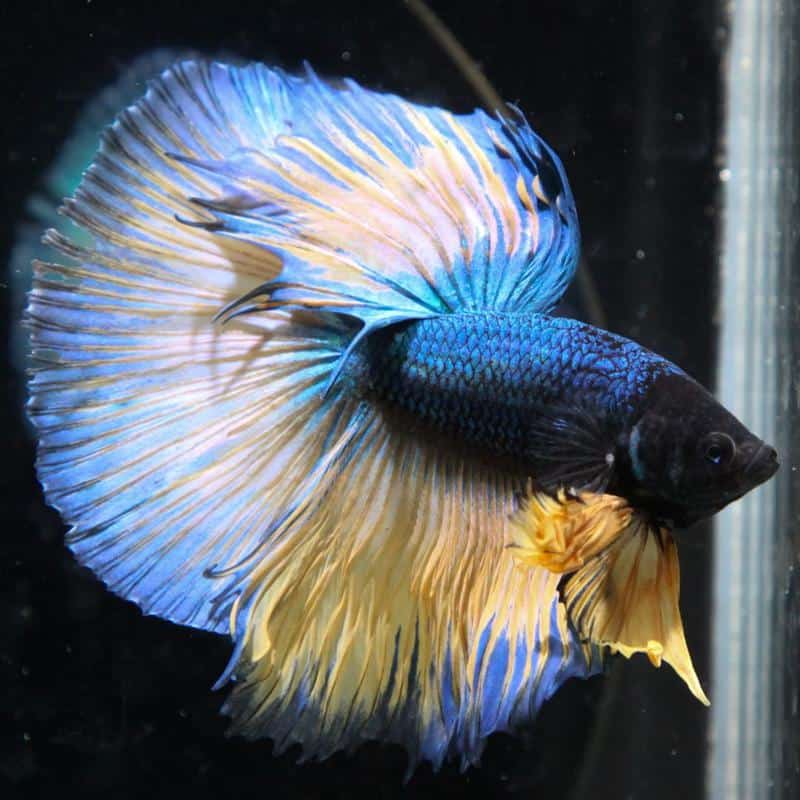
The last layer is the yellow layer, which contains xanthophores. This layer is responsible for the yellow color found in many Bettas.
Interestingly, there’s no actual gene that can cause the color yellow. What happens is that the gene causes a lack of the other colors, with the result being yellow.
However, this layer is also often associated with a trait called opaque, which was originally created and coined by a Dr. Gene Lucas, who also founded the International Betta Congress in the United States in 1966.
Opaque
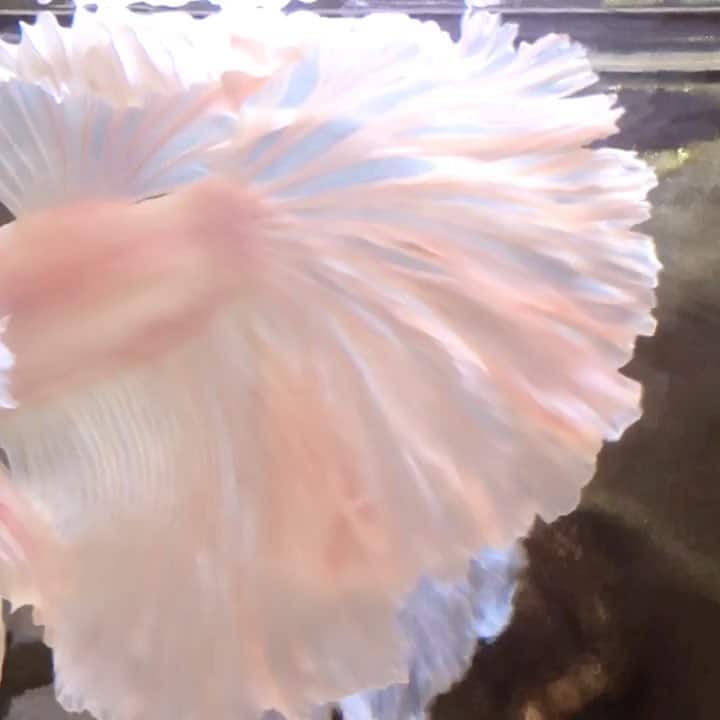
As mentioned above, opaque is actually a trait, not a color. It’s distinguished by a thick, powdered appearance on the Betta’s skin.
There are three different kinds of Opaques: steel blue, green, and blue (royal blue). While many opaque Bettas may appear white, you need to check the sheen in order to figure out what type of opaque it is.
Betta Crossbreeding Chart
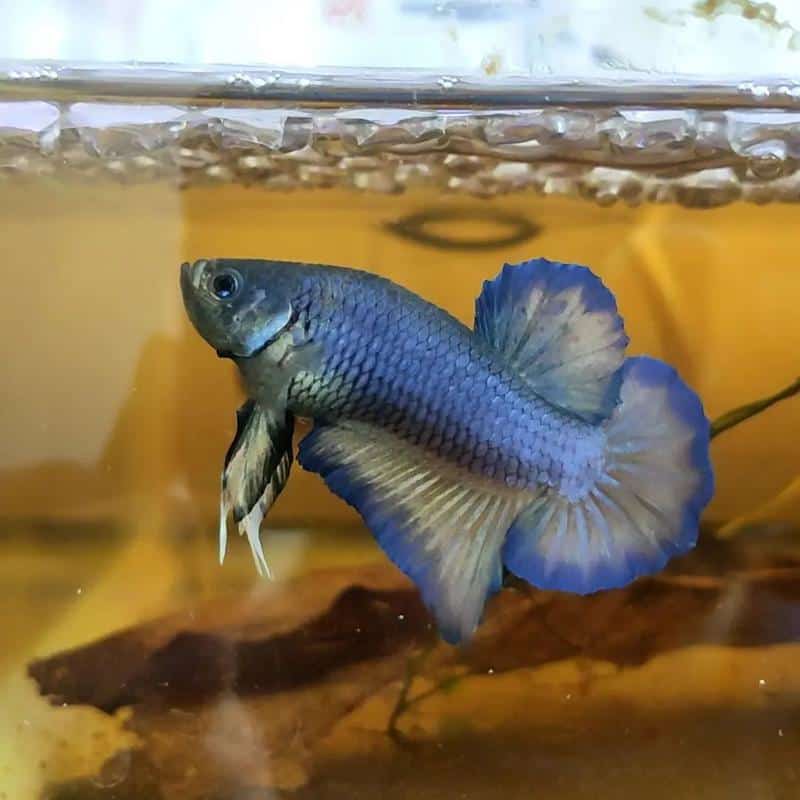
Many breeders have tried to crossbreed between several Betta fish species. In nature, cross breeding does happen, although it happens more frequently when Betta splendens breed with other Betta splendens.
One of the most popularly mated combinations is between Betta splendens, Betta embellish, and Betta mahachai.
Meanwhile, although the Betta splendens and the Betta smaragdine can be cross-bred, this process is rarely successful due to a low survival rate among their offspring.
Additionally, additional fish species have been crossed with the Betta splendens. Here are some tail varieties that you should keep in mind when breeding Betta fish.
Short-Fin vs Long-Fin
Long fins are the dominant trait, while short fins are the recessive trait. If the parents are both long-finned, the offspring is bound to be long-finned as well. If one of the parents is long-finned and the other is short-finned, there’s a greater chance that the offspring will also be long-finned.
Halfmoon
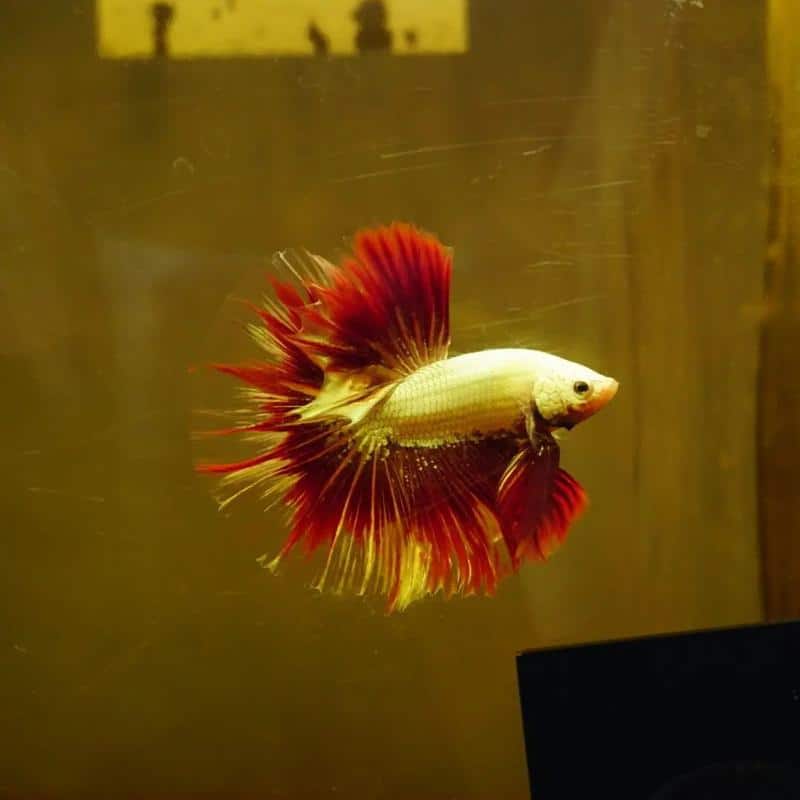
- Crossing Long Fin: Halfmoon (HM) with Short Fin: Halfmoon Plakat (HMPK) results in Super Delta / Halfmoon offspring.
- When Short Fin: Halfmoon Plakat (HMPK) and Long Fin: Crowntail (CT) are bred together, the result is called Halfsun.
- When Long Fin: Halfmoon (HM) and Long Fin: Crowntail (CT) are bred together, the result is also Halfsun.
| MALE PARENT | FEMALE PARENT | OFFSPRING |
| Long Fin: Halfmoon (HM) | Short Fin: Halfmoon Plakat (HMPK) | Super Delta / Halfmoon offspring. |
| Short Fin: Halfmoon Plakat (HMPK) | Long Fin: Crowntail (CT) | Halfsun |
| Long Fin: Halfmoon (HM) | Long Fin: Crowntail (CT) | Halfsun |
Veiltail
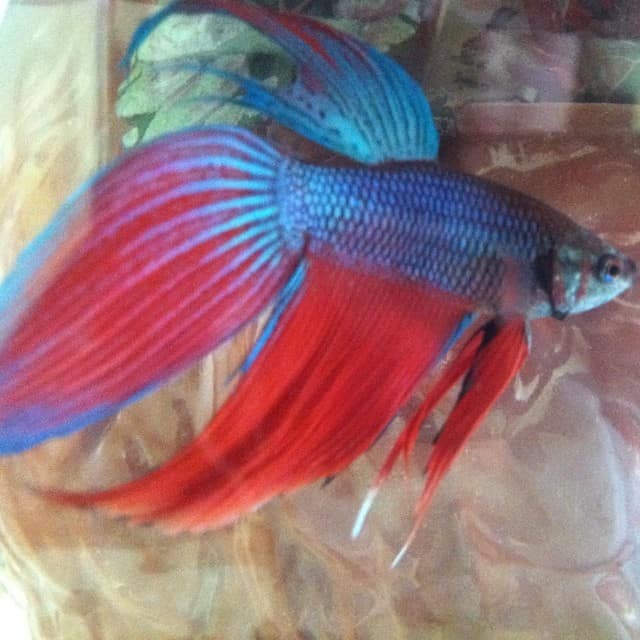
- When Veiltail (VT) and Halfmoon Plakat (HMPK) are crossed, the result is Delta Tail.
- When Veiltail (VT) and Halfmoon (HM) are crossed, the result is Super Delta Tail.
- Crossing Veiltail (VT) and Crowntail (CT) will primarily produce Veiltail with web decrease in their fins. Crossing Veiltail (VT) and Crowntail will result in fins that look untidy (CT).
| MALE PARENT | FEMALE PARENT | OFFSPRING |
| Veiltail (VT) | Halfmoon Plakat (HMPK) | Delta Tail-fries |
| Veiltail (VT) | Halfmoon (HM) | Super Delta Tail |
| Veiltail (VT) | Crowntail (CT) | Veiltail with web |
Crowntail
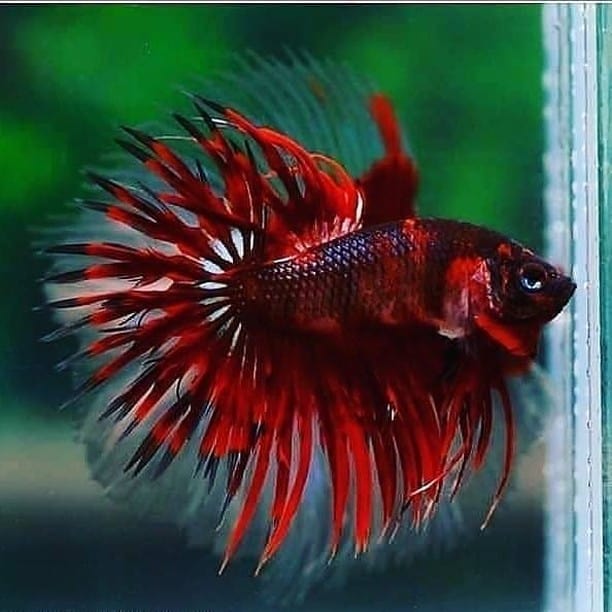
- When Halfmoon (HM) and Crowntail Plakat (CTPK) are bred together, it will result in a Halfsun.
- Veiltail (VT) and Crowntail Plakat (CTPK) crossbreeding will also result in Halfsun offspring.
- Crossbreeding Crowntail Plakat (CTPK) with Crowntail (CT) will result in Crowntail (CT).
| MALE PARENT | FEMALE PARENT | OFFSPRING |
| Crowntail Plakat (CTPK) | Halfmoon (HM) | Halfsun |
| Crowntail Plakat (CTPK) | Veiltail (VT) | Halfsun offspring |
| Crowntail Plakat (CTPK) | Crowntail (CT) | Crowntail (CT) |
Single-Tail vs Double-Tail
Similarly, single-tailed Bettas are the dominant variation. When paired with a double-tailed Betta, the offspring of a single-tailed Betta is also likely to be single-tailed.
DTPK (Double Tail Plakat)
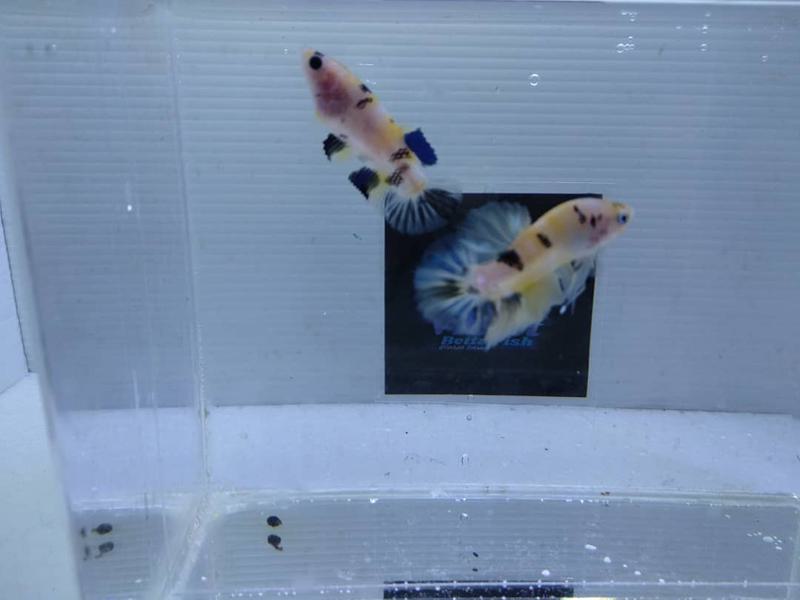
- When Halfmoon Plakat (HMPK) and Double Tail Plakat (DTPK) are crossed, the result is called Round tail (HMPK).
- When Double Tail Plakat (DTPK) and Double Tail Halfmoon (DTHM) cross-bred, Double-Tail Halfmoon is the offspring (DTHM).
- When Halfmoon (HM) and Double Tail Plakat (DTPK) are crossed, Delta Tail is the result.
- When Double Tail Plakat (DTPK) and Crown Tail (CT) are crossed, Halfsun is produced.
- When the Veiltail (VT) and Double Tail Plakat (DTPK) are crossed, the result is a Delta Tail.
| MALE PARENT | FEMALE PARENT | OFFSPRING |
| Double Tail Plakat (DTPK) | Halfmoon Plakat (HMPK) | Round Tail (HMPK) |
| Double Tail Plakat (DTPK) | Double Tail Halfmoon (DTHM) | Double-Tail Halfmoon |
| Double Tail Plakat (DTPK) | Halfmoon (HM) | Delta Tail |
| Double Tail Plakat (DTPK) | Crowntail (CT) | Halfsun |
| Double Tail Plakat (DTPK) | Veiltail (VT) | Delta Tail |
Double Tail Halfmoon (DTHM)
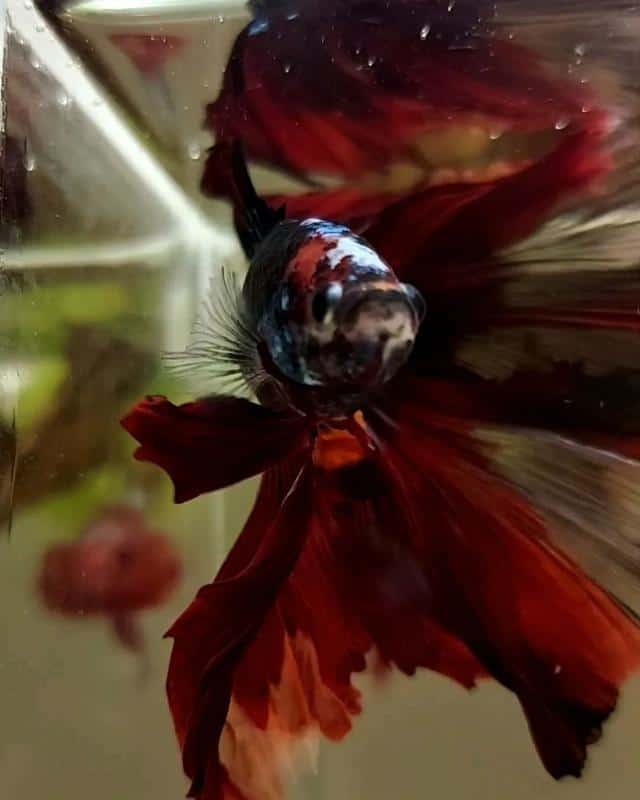
- When Double Tail Halfmoon (DTHM) crosses with Halfmoon Plakat (HMPK), Delta Tail is produced.
- When Double Tail Halfmoon (DTHM) and Crowntail (CT) are crossed, the result is a Halfsun.
- When Double Tail Halfmoon (DTHM) and Halfmoon (HM) are crossed, Super Delta/Halfmoon is the result.
- When Veiltail (VT) and Double Tail Halfmoon (DTHM) are crossed, the result is a Delta Tail.
| MALE PARENT | FEMALE PARENT | OFFSPRING |
| Double Tail Halfmoon (DTHM) | Halfmoon Plakat (HMPK) | Delta Tail |
| Double Tail Halfmoon (DTHM) | Crowntail (CT) | Halfsun |
| Double Tail Halfmoon (DTHM) | Halfmoon (HM) | Super Delta / Halfmoon |
| Double Tail Halfmoon (DTHM) | Veiltail (VT) | Delta Tail |
Pectoral Genes
Some Bettas also have larger pectoral fins than others. However, while this is an impressive trait, it’s not a dominant one. Even if you breed a Betta with a large pectoral fin with one that has normal pectoral fins and doesn’t carry the gene at all, the resulting offspring will still have normal-sized pectoral fins.
Dumbo Betta
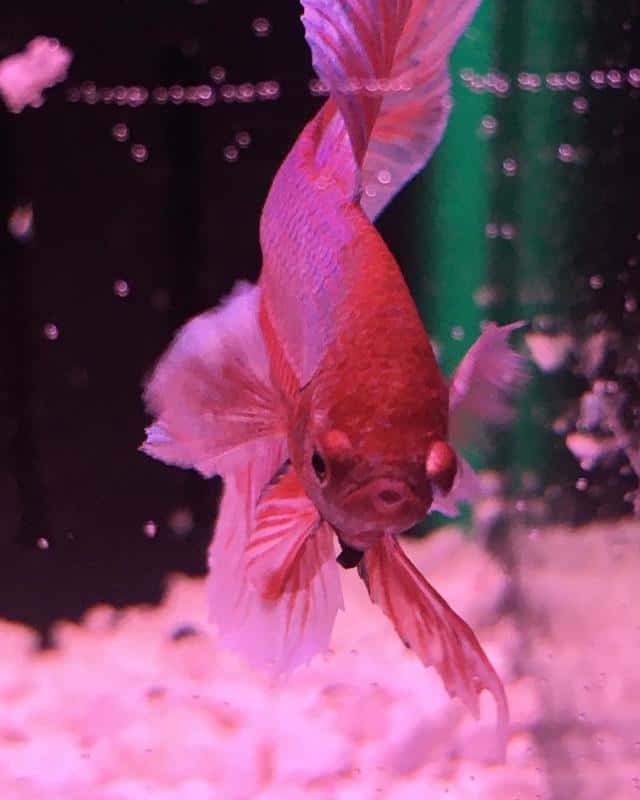
- When Halfmoon Plakat (HMPK) and Dumbo (HMPK) are crossed, the offspring is a regular Halfmoon Plakat (HMPK).
- When Dumbo Halfmoon crosses with Halfmoon (HM), the offspring is a regular Halfmoon.
- When Dumbo Double Tail Plakat (DTPK) and Double Tail Plakat (DTPK) are crossed, Regular Double Tail Plakat (DTPK) offspring are born.
| MALE PARENT | FEMALE PARENT | OFFSPRING |
| Dumbo (HMPK) | Halfmoon Plakat (HMPK) | Regular Halfmoon Plakat (HMPK) |
| Dumbo Halfmoon | Halfmoon (HM) | Regular Halfmoon |
| Dumbo Double Tail Plakat (DTPK) | Double Tail Plakat (DTPK) | Regular Double Tail Plakat (DTPK) |
Betta Colors/Genes
As discussed above, colors can be passed down from parent to offspring through their genes.
Some genes are more dominant than others though, and tend to show up even if only one parent has it. Others require both parents to be carriers of the gene in order to pass the color down to their offspring.
Black (melanistic)
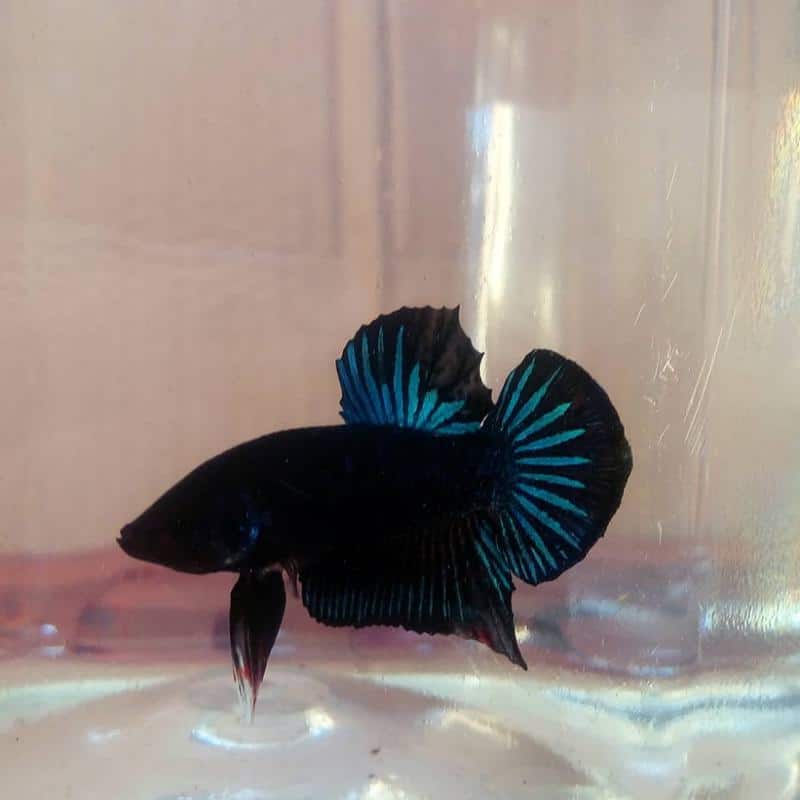
| MALE PARENT | FEMALE PARENT | OFFSPRING |
| Black | Red | 100% Multicolor (Black genotype) |
| Black | Multicolor(Black genotype) | 50% Black, 50% Multicolor (Black genotype) |
| Black | Black | (Black females are infertile) |
| Multicolor (Black genotype) | Blue | 100% Multicolor (50% Black genotype) |
| Multicolor (Black genotype) | Multicolor (Black genotype) | 25% Black, 75% Multicolor (67% Black genotype) |
Iridescent
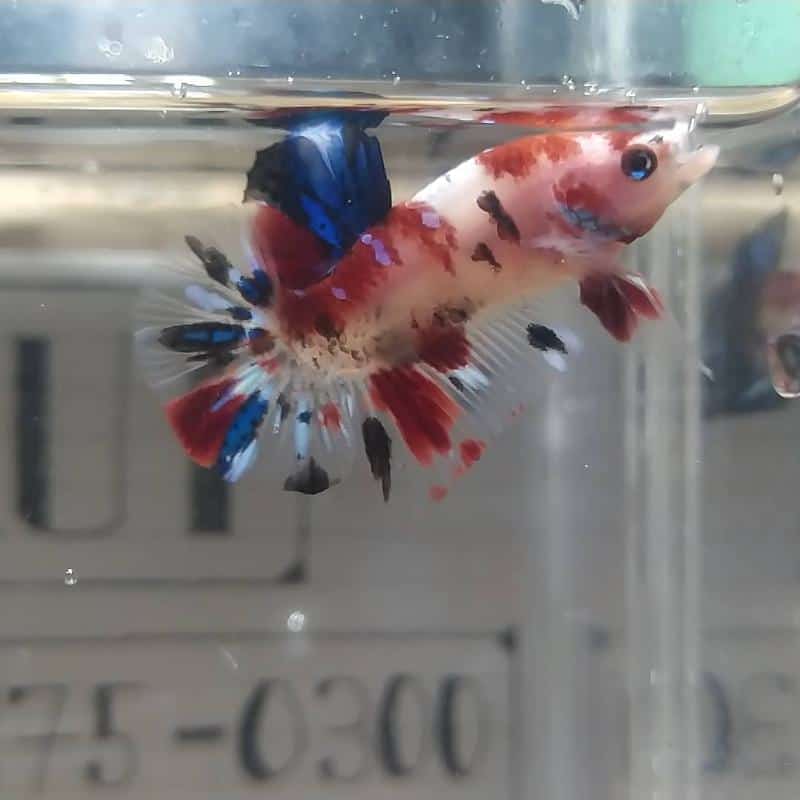
| MALE PARENT | FEMALE PARENT | OFFSPRING |
| Green | Green | 100% Green |
| Green | Blue | 50% Green, 50% Blue |
| Steel Blue | Steel Blue | 100% Steel Blue |
| Steel Blue | Blue | 50% Steel Blue, 50% Blue |
| Steel Blue | Green | 100% Blue |
| Blue | Blue | 25% Green, 50% Blue, 25% Steel Blue |
Melano
Note: F1 = First Offspring, F2 = Second Offspring
| MALE PARENT | FEMALE PARENT | OFFSPRING |
| Melano | Any color | Multicolored (melano geno) |
| F1 (Melano geno) | F1 (Melano geno) | Melano, Melano geno, regular |
| F2 melano | Melano geno | Black melano, melano geno |
Cambodian
| MALE PARENT | FEMALE PARENT | OFFSPRING |
| Cambodian | Irid color | Irid-red multi, red Cambodian (with or without irid layer) |
| Cambodian | Cherry red | Cherry red, Cambodian, a lighter shade of red or darker shade of Cambodian |
| Cambodian | Bright red | Mostly Cambodian like colors with more red on the body, a few red |
| Cambodian | Black | Multi black with red fins |
Purple

There are several formulas that are used to determine if the offspring of two Betta parents will turn out purple.
German aquarist Marcus Gutzeit’s formula says that a red female crossed with a pinkish male from a multicolored line will result in a purple-colored offspring.
| MALE PARENT | FEMALE PARENT | OFFSPRING |
| Pinkish | Red | Light Purple/Bubblegum |
Meanwhile, Betta breeder Victoria Parnell’s formula states that a black-red and steel (melano geno) cross between a blue-red female and a male from the BF line will result in purple-blue offspring.
| MALE PARENT | FEMALE PARENT | OFFSPRING |
| Black-Red and Steel (melano geno) | Blue-Red | Purple-Blue |
| Blue-Red | Black-Red and Steel (melano geno) | Purple-Blue |
Red

Cherry red is the usual or typical shade of red that we see in Betta fish, while extended red is a more vivid red. These are pretty easy to get just by breeding Betta parents with any red gene.
| MALE PARENT | FEMALE PARENT | OFFSPRING |
| Cherry red | Cambodian without iridescence | Cherry red, Cambodian, a lighter shade of red or a darker shade of Cambodian |
Non-red (Yellow, Orange)
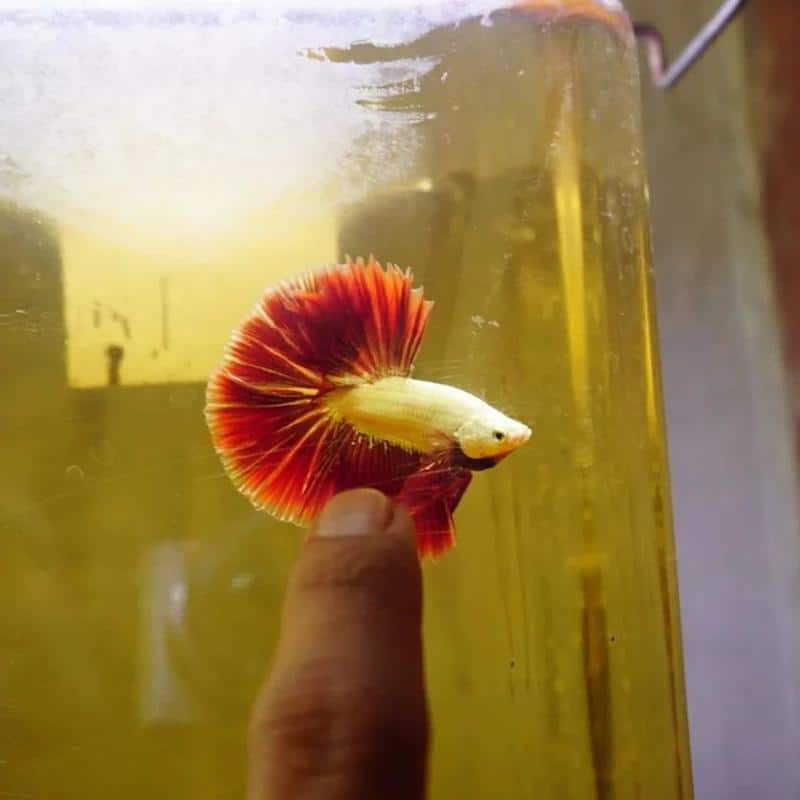
Although non-red genes (nr1, nr2) have been found, it takes a combination of genes for yellow or orange to physically manifest. Due to its extreme recessiveness toward all other hues, this color is unlikely to appear when it is crossed with another.
| MALE PARENT | FEMALE PARENT | OFFSPRING |
| Extended red | Cambodian (pale body or no iridescence) | Yellow and/or Orange |
How to Set Up a Betta Breeding Tank
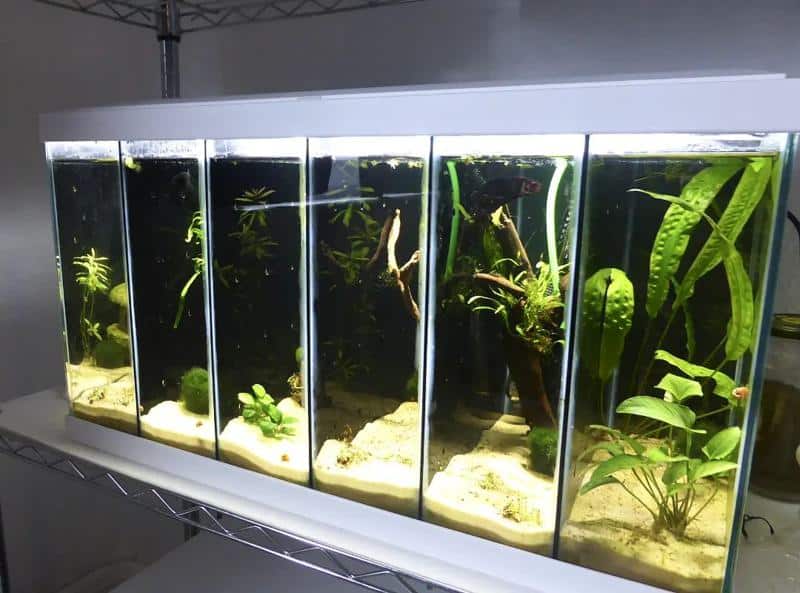
While the charts above are by no means an exhaustive list, they should be enough for now to get you started on the world of Betta fish breeding.
Before you can do that, though, you’ll need to set up the breeding tank. Here’s how you can do this.
Things You Need
- For mature fish, there must be two completely equipped and cycled tanks.
- Your breeding tank should be a 10-gallon aquarium that is empty but has a glass kit for evaluating pH, GH, ammonia, nitrite, and nitrate levels in the water.
- Styrofoam cup, java moss, Indian almond leaves, and plastic wrap.
- A tall glass vase or jar (6 inches or more), or a partition for your breeding tank.
- For water changes and maintenance, a bucket and a siphon with a hose or tubing.
- Tasty food like brine shrimp, bloodworms, and daphnia eggs that are either fresh or frozen.
Step-by-Step Guide
- Put your 10-gallon aquarium in a quiet area away from lights. Make sure it’s set evenly on a solid, aquarium-safe table or shelf.
- Next, 3 to 5 inches of conditioned water should be added. It can also be toxin-free water from another healthy betta tank to help jump-start the cycling process.
- Set the temperature to 80°F and add an aquarium heater, tilting the tube to completely submerge the device.
- Put a sticker or temperature gauge on the tank, making sure the gauge is positioned below the waterline.
- Set up your air stone or sponge filter and baffle in the tank and use plastic tubing to link it to the air pump.
- Examine your tools, and if everything seems in order, plug in the heater and air compressor.
- After running your heater and filter for 24 hours, check the flow and temperature to make sure they’re in the right range.
- Use artificial silk plants with a fine texture or some floating plants, such as Java moss or moss balls, in order to simulate their natural environment.
You should also put something at the water’s surface so that the male betta can create his bubble nest there before mating, in addition to hiding spots. Indian almond leaves, plants with broad leaves that touch the surface, and small pieces of Styrofoam all work well.
This stage of betta fish reproduction is vital because the bubble nest guards the fry and allows the female to recover.
How to Start the Breeding Process
Once the tank is ready, you can begin breeding your Betta fish and welcoming new additions to your family.
Set up your Tank
Obviously, the first step is setting up the tank, which we already covered above. The success of Betta fish breeding hinges partly on whether the environment in the breeding tank is ideal for creating a long-lasting bubble nest and allowing the eggs to hatch.
You should make sure that your betta breeding tank is completely cycled before introducing the betta fish that you intend to breed. This will aid in preventing chemical spikes, which can harm betta fish spawning populations or possibly kill betta fry.
Select and Condition the Pair
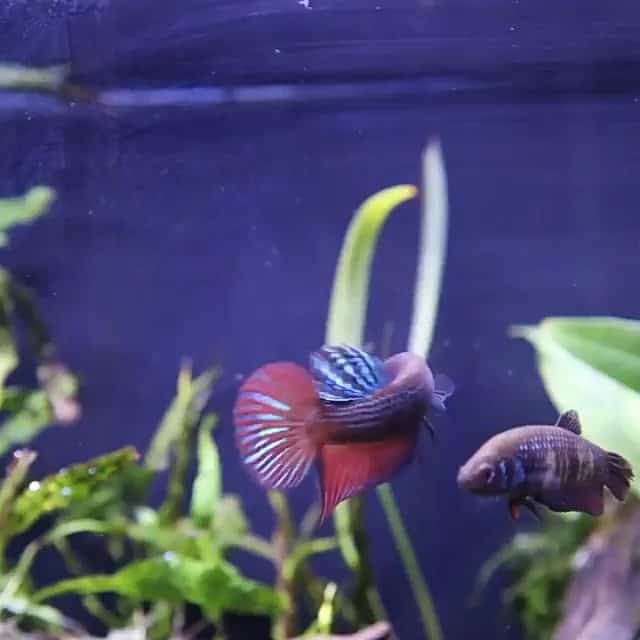
Next, it’s time to select and condition your breeding pair. Start giving them high-quality, nutrient-rich foods to maintain their optimal health.
The pair will have to work very hard to breed, so you’ll want to make sure they’re getting the right nourishment to support this. We also advise providing thawed frozen fish meal that is high in protein.
Regularly changing the water will also help in conditioning your fish. Prior to reproducing, your Betta couple needs to be in tip-top shape for at least 10 days.
Add the Female to the Breeding Tank
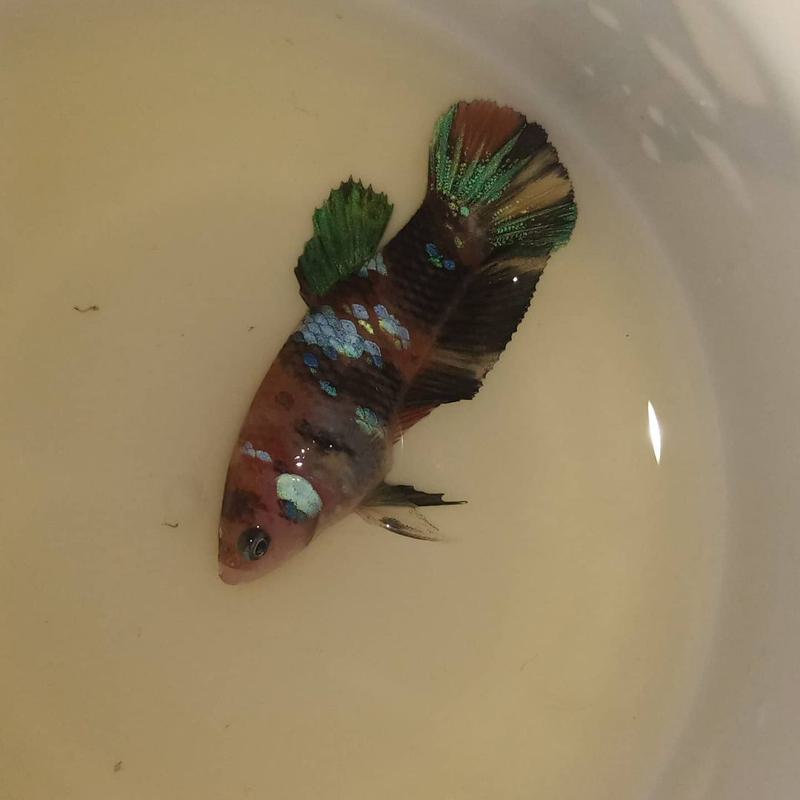
It’s crucial to keep the female betta fish separated from the male until the fish are prepared to breed.
That’s because Bettas are highly territorial, even towards other sexes. You wouldn’t want your fish to harm each other–or worse.
Luckily, this can be easily accomplished by using a divider, such as a standard aquarium divider, or a tall glass wall that is open at both ends, to separate the female from the male.
Introduce the Male to The Female Betta
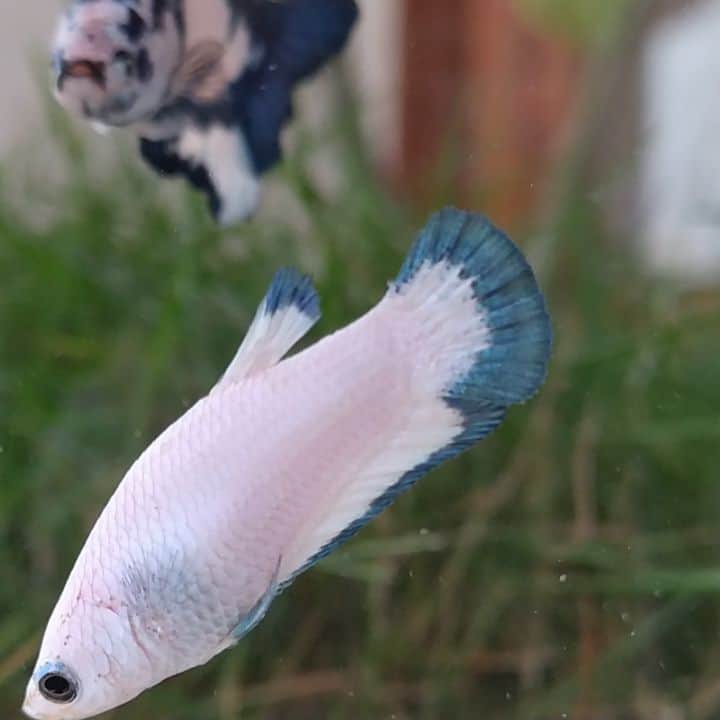
Once both fish are placed in the breeding tank, this is when the breeding actually starts. Even though they are unable to communicate, the male and female will come to know one another at this point and start to show signs of readiness to spawn.
The male betta fish will start to dance around the female after he notices her and will flare his fins at her to get her attention. Additionally, his hues will deepen and intensify.
The female betta will also undergo some noticeable changes. Her hues will likewise deepen, and her body may even develop dark stripes. Make sure that the stripes are running vertically, as horizontal stripes mean that she’s simply stressed and is in no condition to breed.
Read More:
- Can Betta Fish Live Together?
- Can You Put a Male and Female Betta Together?
- 10 Common Betta Fish Behaviors Before Death
Tips When Breeding Betta Fish
Breeding Bettas is no easy feat, so here are some handy tips to keep in mind when you’re trying to make them spawn.
Monitor the Breeding Tank Constantly
Any sudden changes in behavior, water parameters, or physical characteristics can have a huge impact on breeding success. It’s important to remain vigilant when breeding bettas, particularly in the early days of breeding.
Observe the Female’s Behavior
The female may be quiet and reserved depending on her nature, but she should not appear distressed or disoriented. If she starts to act weird, it’s time to take her out and make sure the breeding tank remains healthy.
Additionally, if she doesn’t seem interested in the male or even actively avoids him, it’s probably best to take her out of the breeding tank and choose a more compatible female.
Avoid Breeding Betta Fish Too Early
There’s such a thing as breeding bettas too early. Avoid breeding fish that are younger than 6 months of age, as they may not be mature enough to produce healthy offspring. It’s also important to give your breeding pair time to condition and get used to each other before breeding.
Know Your Breeding Pair’s Genetic Background
If you want to produce healthy, strong offspring, it’s important to know the breeding pair’s genetic background.
This information can help you decide which bettas make the best breeding partners and how to adjust your breeding tank accordingly. It’s also a good idea to consult a professional if you need advice on breeding bettas.
Keep in mind that not all show fish make good breeders, and not all breeders make good show fish. The genotype is not necessarily revealed by the phenotype.
A phenotypically less attractive fish from a quality line, where some crucial traits have been fixed through several generations, is to be expected to perform better than a fish with more attractive phenotypes from a large spawn.
Also, it’s not always just genetics. Environmental factors like food, temperature, and water quality also play a role, so make sure these conditions are optimal when breeding betta fish.
Be Patient Throughout the Process
Finally, make sure you have enough patience. Breeding Bettas can be a long and sometimes challenging process, but it’s worth the effort when you see your breeding pair producing healthy, strong offspring. Just remember to take your time and enjoy the process.
FAQs
How Long Does It Take to Breed Betta Fish?
You should see the male begin constructing his bubble nest an hour or so after the initial introduction. He’ll spend his time switching between constructing the nest and strutting his stuff.
The nest should expand over the course of three days, by which time the female fish should have laid enough eggs in her body to allow for breeding.
Make sure you cover the tank with paper or plastic to offer the couple some privacy. You risk scaring/distracting the fish if you walk by the tank frequently, which could prevent them from reproducing.
How Do I Know if My Female Betta Is Ready to Breed?
The female Betta will darken in color, show more of her ovipositor, and develop vertical bars all over her body when she is ready to mate.
The male’s bubble nest will likewise be accepted by her. In male bettas, a deeper hue also indicates readiness. In an effort to impress the female, males will also flare their fins at her and create a bubble nest.
Conclusion
Good breeding betta fish practices are important for the health of both the breeding pair and their offspring.
It’s important to understand the breeding process and have an understanding of genetics, as well. The breeding tank should be monitored closely and environmental factors such as temperature, water quality, and food should all be checked.
With these in mind, you can now begin breeding your beautiful betta fish!
